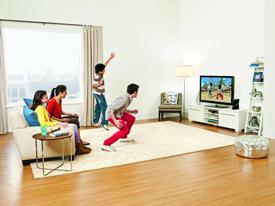
Motion-based video gaming is more popular than ever, but have our living rooms caught up with the trend’ This promotional photo for Xbox Kinect features a family with the perfect motion gaming space.
It used to be a stereotype that gamers spend large amounts of time in small, dark rooms playing video games.
Well, the times, they are a-changing.
Motion gaming is here, and whether we like it or not, it’s staying for a while. The problem is, a lot of people just don’t have the room for it.
When Nintendo released the Wii in 2006, it popularized motion gaming for the masses. Everyone and his mother (and probably his mother’s mother) was waggling the Wii remote around. It didn’t take long to figure out, however, that you didn’t really need to go through the full motions to make the Wii work.
In 2009, Nintendo released Wii MotionPlus accessory, which allowed for one-to-one motion controls. Still, they weren’t so powerful that one had to really get off the couch, and few games actually use the thing.
In 2010, Sony and Microsoft brought their own motion controllers out. And now I need a new living room.
Sony, which had dabbled in motion controls before with the EyeToy for the PlayStation 2, developed a new device for the PlayStation 3: the PlayStation Move, which uses a camera — the PlayStation Eye — and Move controllers that are tracked by the Eye.
Microsoft launched for Xbox 360 the controller-less Kinect, a camera that impressed many with its accuracy while tracking the human body.
While they’re both great fun, they also require a lot of room. That’s a luxury that not everyone has.
Back home, my family has an L-shaped basement, which doesn’t allow for much room between the TV and the couch. Enough to avoid eyestrain, sure, but to run? To fight? To dance? Absolutely not.
A friend and I had to put the PlayStation Eye on top of a box on top of the television and then sit on our knees on the couch to play Sports Champions with Move. Why? To trick the camera into thinking we were far enough away. It wasn’t optimal, but it worked for a few games of disc golf and bocce ball.
I haven’t yet tried Kinect in my own home or apartment, but I did try it in my local Best Buy. The store had an area, perhaps about six feet or so, squared off. While I played Kinect Sports (and amused many shoppers, I’m sure), it kept asking me to move back until I hit the wall. Calling up a picture of what Kinect could see showed it was tracking me from my head to my calves. It worked pretty well without the foot data, but it wanted to see my entire body.
So what do you do in a house or an apartment without this kind of space? On the Xbox Support website, Microsoft recommends six feet of space for one player and eight feet of space for two. On Sony’s blog, they state the “ideal” range is five to nine feet away from the camera, though it should work as close as two.
While were able to play Move on our knees, we didn’t tolerate that for very long. Eventually, we found a way to turn the TV so that we avoided any furniture. We were about five feet away from the PlayStation Eye. Even then, I hit the wall with a Move controller due to limited space (don’t worry — the wall’s OK.)
I’ve managed to make Move work in my small apartment as well by moving the camera or the TV to odd angles.
“Maybe this would work with Kinect,” I thought. I haven’t had the chance to try Kinect in-depth (though I’d love to), but I imagine I’d still have some trouble. In my basement back home, I doubt I could fit two people flailing around. We came too close for comfort with Move.
In my apartment, there’s a coffee table in our common area. Kinect doesn’t do coffee tables. I’m not an engineer, but I’m hard-pressed to think of where I would put a table in the apartment other than in between the couch and the TV.
So what’s my solution? It’s simple. We all get bigger living rooms. Someone has a huge, pristine living room with nothing but a couch and a television, right? They’re in the advertisements!
My solution, quite obviously, is not a plausible one.
It’s a problem going forward. The United States probably has some of the largest living spaces in the world. Have you seen an apartment in Japan? I haven’t, but I’ve read about them, and they’re apparently too small to comfortably house these devices.
Motion gaming is about inclusion. It’s a way to get potential gamers who aren’t interested in complex controllers to play in a way that’s more natural to them, while attracting current gamers with new control schemes. Yet the newest forms of motion gaming have limitations. I was just able to make Move work, but I wonder whether I could do the same with Kinect in such limited space.
There are ways to make these motion controllers work. It’s not easy. I’ve heard of people turning televisions, moving furniture around and even putting small tables under bigger tables, all for more space. Others have just given up because they don’t want to move their coffee tables back and forth.
Many games are coming that require these new motion controllers, and not everyone can fit them.
As a fan of new and innovative thinking in gaming, I hope some of Microsoft and Sony’s programmers and engineers can find a way to reduce the necessary space.
In the meantime, there is always enough room for buttons and joysticks. Also, waggle.
afreedman@umdbk.com



